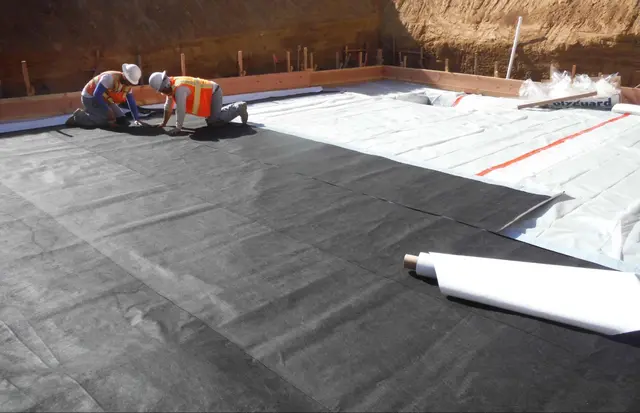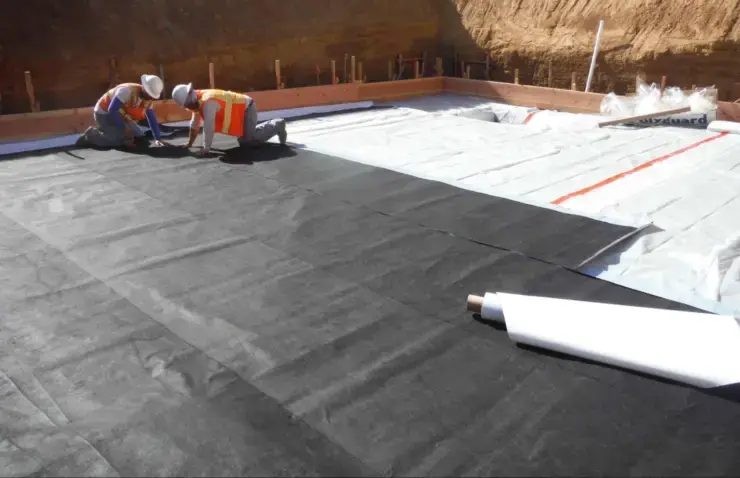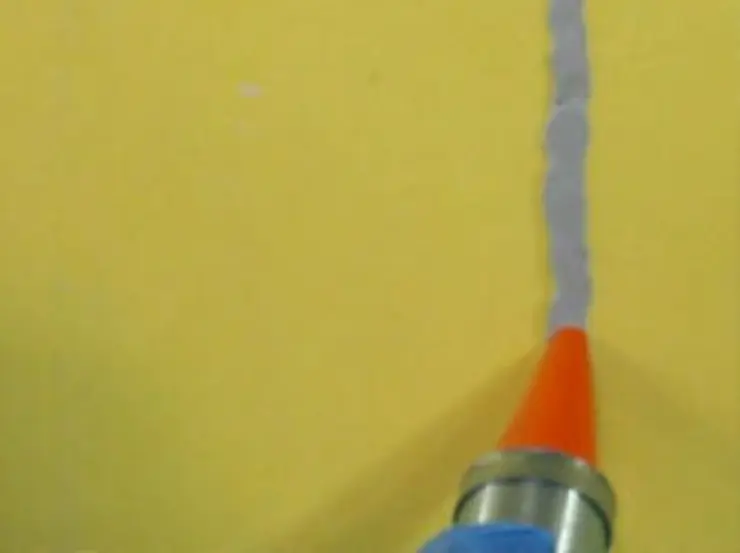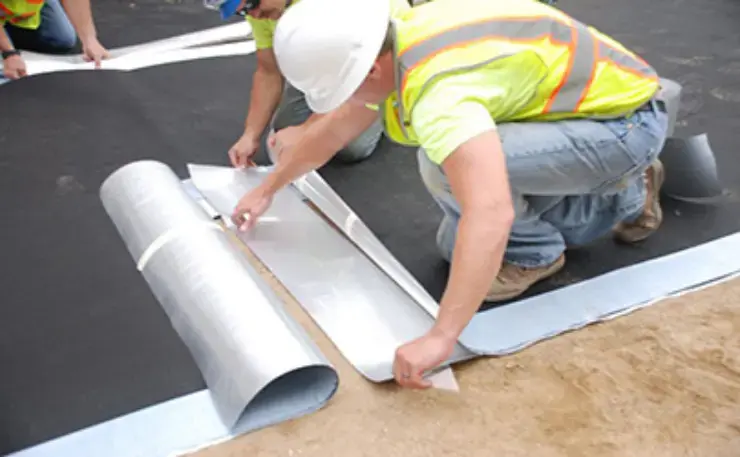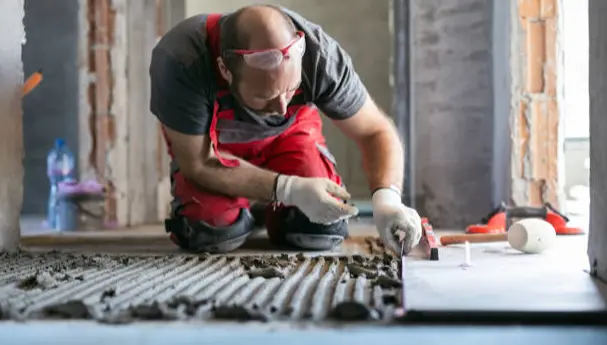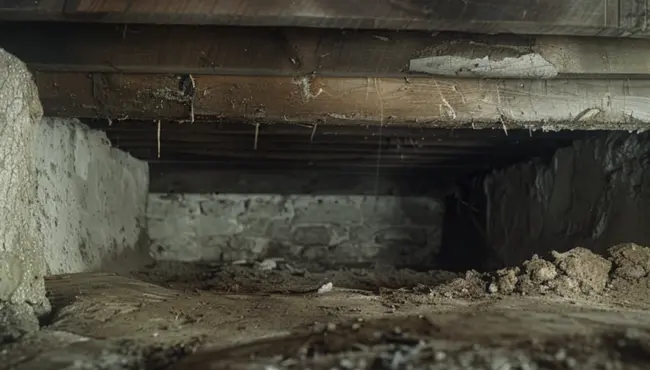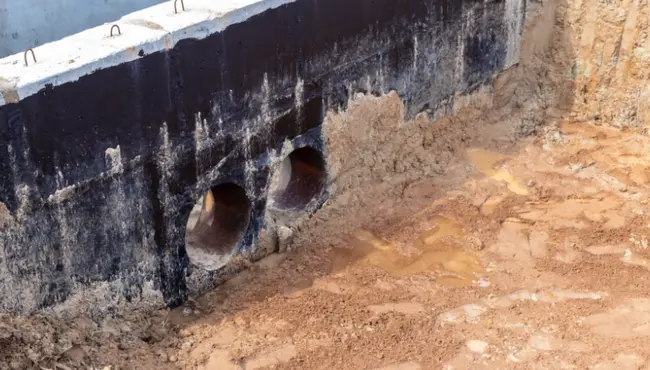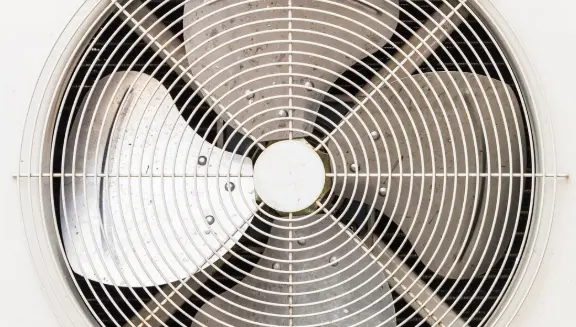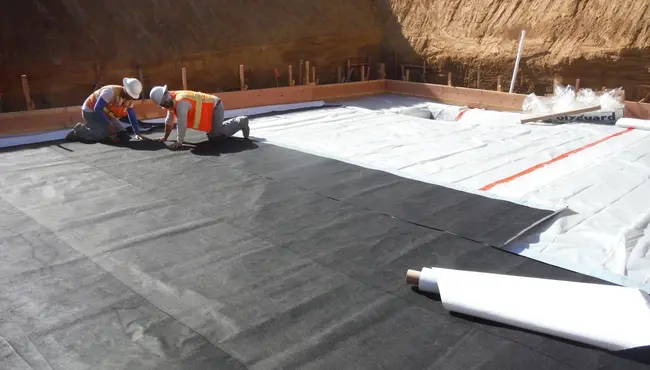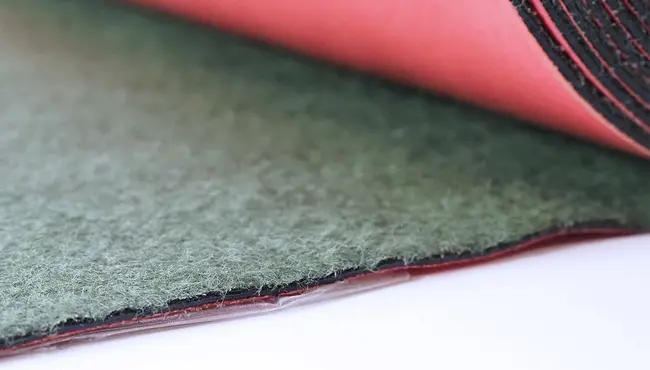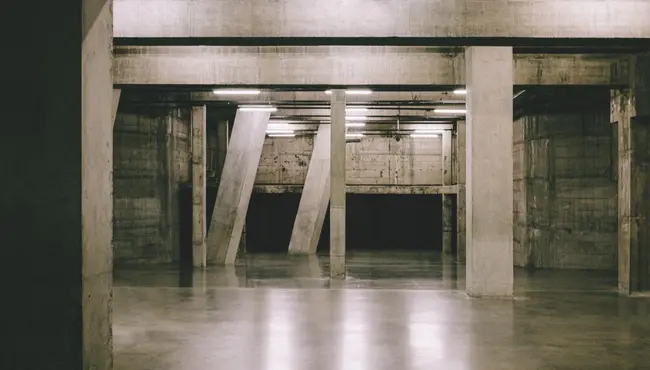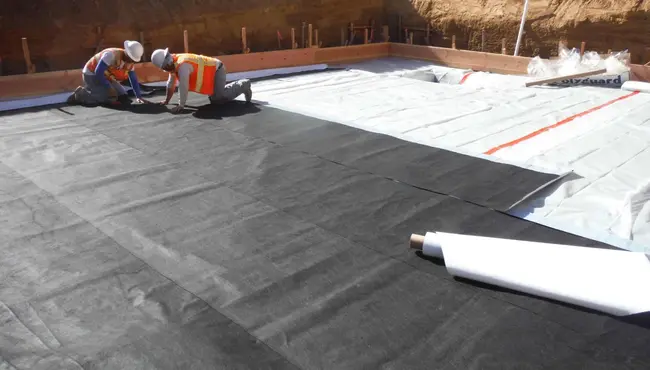Decks require under-deck waterproofing to preserve the deck's durability, aesthetic quality, and service life. Protecting your under deck from moisture intrusion and accumulation will minimize or prevent the growth of structurally damaging mold and corrosion. It will also reduce maintenance and repair expenses. In addition, waterproofing under your deck will help protect your home or building's value. Therefore, waterproofing under a deck must include high-quality materials and techniques.
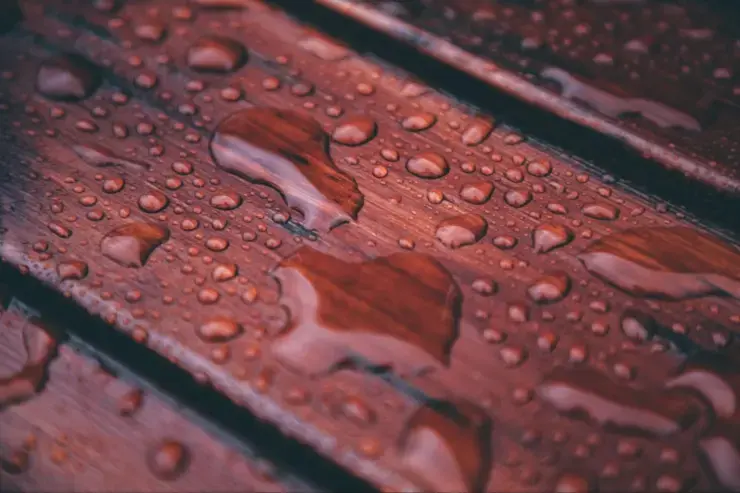
How Much Does it Cost to Waterproof Under a Deck?
The cost to waterproof under a deck varies based on complexity, size, prep needs, accessibility, and regional worker rates. However, waterproofing a deck typically costs between $551 and $1299, or $0.75 to $4.00 ft2 for labor and materials. Notably, labor makes up 50 to 75 percent of the total price.
How to Waterproof Under a Deck?
Understanding how to waterproof under your deck by researching the best deck floor waterproofing techniques and materials, like under-deck drainage panels, deck joist tape, and substrate moisture barriers, will help you maintain your new deck's integrity and expected lifespan.
Polyguard offers all the high-quality products you need to waterproof under a deck:
In addition, Polyguard offers other vital products to help ensure a water-tight under deck: liquid adhesive, flashing membranes, outside corner boots, sealants, detailed tape, and liquid membrane.
How to Waterproof Under Deck - Install Under Deck Drainage Panels
Under deck drainage panels installed above or below the joists will catch and direct water away from the deck to one of three deck areas – below the joists, between the decking and joists, the deck's surface, or below the joists.
How to Waterproof Under a Deck for Storage
A superior under-deck drainage panel system, like the Polyflow® BD Sheet Molded Drainage Mat, protects the deck's substructures from moisture and helps protect the deck's attractiveness and long-term integrity. In addition, the deck drainage panel will protect the usable storage and living space below, even in harsh weather conditions.
How to Waterproof Under a Deck DIY
A straightforward-to-install deck drainage panel will help guarantee an adequately placed and functioning deck drainage system. A simple method to install drainage deck panels will reduce the need for skilled workers and specialized, costly tools – to save contractors and DIYers' time and money. You may also want to consider a deck drainage system that permits electrical and gas installation and allows you to add features like ceiling fans, lights, etc., to the below-deck area.
How to Make Under Deck Waterproof with Polyflow® BD Sheet Molded Drainage Mat
The Polyguard engineered lightweight, high-capacity Polyflow® BD Sheet Molded Drainage Mat, compatible with Polyguard's Balconyguard™ Membrane, is a solution to lightweight under-deck drainage that produces pathways for deck water management. The fabric allows water flow to drainage exits. In addition, the punched core enhances the water release rate in the system.
The Polyflow® BD Sheet Molded Drainage Mat has a geocomposite of a fabricated pre-punched impermeable polymeric core, with both sides covered with a non-woven filter fabric. Polyflow® BD's flow rate of 12.5 g/min/ft and compressive strength of 5,200 lb/ft2 can be used in foot-traffic-only decks with less than 3-inch concrete
Easy-to-install Polyflow® BD ensures successful installation and efficient removal of water from the deck, to lengthen its lifespan and save money and time during and after installation.
How to Waterproof Under My Deck - Apply a Quality Deck Joist Tape
Self-adhering, cold-applied deck joist tape flashes the deck joints and ledger boards. It creates a durable moisture and debris barrier between the non-corrosive galvanized metal hangers and treated lumber to stop water damage to vulnerable joists.
How to Waterproof Under a Wood Deck?
Without the moisture barrier made by the deck joist tape, water and debris can accumulate in the areas between the deck boards and joists, which can break down the wood joists (treated and untreated or treated) and cause damaging rot. Joist tape between the metal hangers and treated wood can stop leaching copper (a treated wood preservative) from corroding the joist hinges that hold the deck together.
A quality deck joist tape, like PolyWall Rot Shield Joist Tape, will protect the ledger board, deck joist, and rim joint against wood rot and decay, to maintain the deck's integrity and minimize costly and time-consuming repairs. The flashing tape also prevents water intrusion and helps seal around hidden deck fasteners, screw holes, and metal fasteners to stop corrosion and cracks in the metal surface.
How to Make Under a Deck Waterproof with PolyWall Rot Shield Joist Tape

Simple-to-apply, PolyWall's (a division of Polyguard Products Inc.) Rot Shield Joist Tape protects your new deck's value and integrity by creating a durable barrier between the ledger board, joists, and deck board, which prevents damaging water, mold, rot, and fungus. Moreover, Rot Shield Joist Tape limits corrosion by avoiding contact between the treated wood and galvanized metal fasteners and treated wood.
PolyWall's Rot Shield Joist Tape includes a rubberized asphalt 'sticky' compound with a high-density polyethylene (HDPE) plastic film face that protects the deck's integrity by stopping water damage and corrosion. In addition, contractors can apply the tape in cold weather and without priming, and the tape's brown-colored camouflages the below deck boards.
How to Make Under Your Deck Waterproof - Apply Deck Moisture Barrier
Moisture barrier options for deck floors include wet/liquid and rolled/sheet membranes, which can bothh can help waterproof under the deck. Most builders prefer the more effective rolled waterproofing because they can create a more even moisture barrier surface than less costly wet membranes. However, the moisture barrier’s success significantly depends on the installer following the manufacturers’ instructions.
How to Waterproof Under Existing Deck
Before deciding on a deck floor moisture barrier, check the flooring for holes or cracks. If present, remove the finished floor layer to expose and check the substrate (typically wood or concrete) — the last line of defense between the crucial below-deck structural parts.
In addition to installing a high-quality moisture barrier, like Polyguard’s Balconyguard™ Membrane, you must ensure positive drainage of the deck with a minimum slope of 2 percent (¼-inch per foot).
How to Waterproof Under a Raised Deck with Balconyguard™ Waterproofing Membranes
Balconyguard™ rolled (sheet) membranes come in long, adhesive sheets that cover the subfloor or substrate. They create an even surface and act as a reinforcement layer for the subfloor. In addition, rolled membranes install quicker and easier than liquid membranes.
How to Waterproof Under Deck Storage?
Polyguard’s Balconyguard™ Membrane, along with our high-quality companion products, is a superior rolled moisture barrier option that contributes towards waterproofing under a deck and creating usable, dry under-deck space.
Polyguard has engineered our self-adhesive, 60-mil Balconyguard™ Waterproofing Membrane explicitly for wood decks, balconies, and terraces covered with lightweight concrete.
Straightforward to install, Balconyguard™ Membranes offer several significant advantages for waterproofing decks covered with lightweight concrete:
- The Balconyguard™ System includes custom corner boots to save contractors money and time to simplify installation and detailing.
- High-strength PET film
- Treated removable release film
- Tensile strength meets ASTM D412
- Elongation meets ASTM D412
- 48-inch wide by 50-feet rolls (200 ft2 rolls), minimizing seam occurrence by up to 25 percent, compared to 36-inch wide products — a time-saving feature that reduces the number of required seams
Before installing Balconyguard™ Membrane, we suggest contacting Polyguard Technical Services or an authorized company representative for assistance with job-specific shop drawings or details.
Ensuring a Waterproof Under Deck with Polyguard Companion Products
Polyguard 650 WB Liquid Adhesive
Priming dry surfaces with 650 WB Liquid Adhesive ensures the dust-free substrate required for applying Polyguard Waterproofing Membranes. Features of the rubber- and water-based 650 WB Liquid include:
- Low-tack adhesive offers excellent adhesion
- VOC content of 5 g/L
- Pink color
Polyguard 105 Flashing Membrane
Polyguard 105 Flashing Membranes redirect water along with the exterior flashing application, including the flange flashings, spandrel beams sills, and copings door and window headers.
Polyguard Balconyguard™ Outside Corner Boot
60-mil, simple-to-install Balconyguard™ Outside Corner Boot (a combination of asphalt and polyethylene) simply applies to the deck’s outside face at the wall-deck interface. The 6-inch x 6-inch x 6-inch boots come 25 to a carton, to save time and labor on the job site.
Polyguard Detail Sealant PW™
Flexible, high-performing, non-corrosive, and non-staining Polyguard Detail Sealant PW™ fills small gaps at head joints, concrete masonry cracks, penetrations, cast concrete cracks, and gypsum sheathing joints, for a continuous smooth surface. Polyguard Detail Sealant PW™ applies to most below-grade waterproofing applications at penetrations and terminations, along with trowel-on rough openings of flashing/waterproofing above-grade uses.
Polyguard Detail Tape
Robust, flexible, and self-adhesive sheet Polyguard Detail Tape consists of high-density polyethylene, cross-laminated film bonded to a rubberized asphalt waterproofing compound surface.
Polyguard Detail Tape applies as detail strips on the outside and inside corners, penetration control joints, cold joints, and expansion joints to patch damaged membrane spots.
Polyguard LM-85 SSL
Polyguard LM-85 SSL is a two-component, semi-self-leveling, asphalt-modified, urethane liquid membrane available in a pourable sealer. The Polyguard LM-85 SSL has been designed for use in conjunction with the Polyguard waterproofing membrane in Dual Core and pitched pan applications.
Let PolyWall Help Waterproof Under Your Deck
Your deck's long-term value, integrity, and aesthetics require adequate under-deck waterproofing with products like Polyflow® BD Sheet Molded Drainage Mat, compatible with Polyguard's Balconyguard™ Membrane, and PolyWall Rot Shield Joist Tape. You will also need to routinely maintain and repair the deck. Proper maintenance and design will contribute significantly to your deck's beauty and long-term enjoyment.
Contact the Polyguard professionals today for more on waterproofing under a deck and making your deck last a lifetime.
